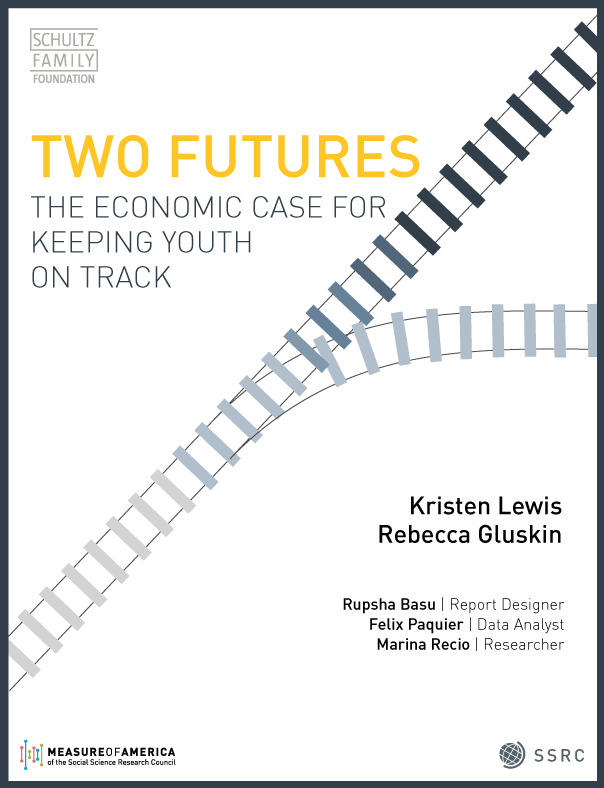Two Futures: The Economic Case for Keeping Youth on Track
To see the most recent data, read the latest report in the youth disconnection series: A Disrupted Year: How the Arrival of Covid-19 Affected Youth Disconnection.

LAUNCHED OCTOBER 9TH, 2018.
Read the full report here. Read the media release here.
Building on Measure of America’s Disconnected Youth Series, Two Futures: The Economic Case for Keeping Youth on Track finds that by the time they reach their thirties, those who had been working or in school as teens and young adults earn $31,000 more per year and are 45 percent more likely to own a home, 42 percent more likely to be employed, and 52 percent more likely to report excellent or good health than those who had been disconnected as young people.
Three features of this paper break new ground:
- We follow a large group of previously disconnected individuals over time to track their life trajectories approximately five, ten, and fifteen years after their period of youth disconnection.
- We look at the effects of the duration of disconnection, assessing differences among individuals who were disconnected for one, two, or three or more years.
- We estimate the future costs of disconnection, both for young people who experience it and to the communities in which they live.
We focus in particular on five key factors: education, earnings, homeownership, employment, and health.
Disconnected youth, also called “opportunity youth,” are teens and young adults ages 16 to 24 who are neither working nor in school.
Given the difference in earnings between the connected and disconnected, Measure of America estimates that the federal government would eventually gain, on average, $11,900 per year in additional tax revenue for each young person who remains connected. That adds up to roughly $55 billion in potential federal revenue gain per year when multiplied by the 4.6 million teenagers and young adults ages 16-24 who are neither in school nor working. Two Futures also goes further to estimate the potential economic gain of reconnecting young people in four cities—Atlanta, Dallas, Los Angeles, and Washington, DC—factoring in tax revenue, public health and housing assistance, and justice costs.
The report makes the case that investing in early-career workers can provide positive returns, laying out the following agenda for action:
- Listen and respond to the views and voices of youth themselves.
- Support at-risk, first-time workers with training and policies that help them stay employed.
- Work together across fractured systems. Businesses can support and even spur collective action among schools, the criminal justice system, health-care systems, financial systems, philanthropy, workforce development boards, and others to tackle the unequal conditions of daily life that persist in high-disconnection communities.
- Set data-driven goals and measure progress toward them.
“Deploying state-of-the-art longitudinal data, Two Futures sounds the alarm on the disconnected youth in our society. The report shows that a lack of integration into school and the world of work during the critical period of ages 16 to 24 evinces enormous personal and societal costs that persist for decades. The effects of (dis-)connection persist even when comparing adolescents and young adults from families with the same income level and demographic characteristics. That is, a disconnected youth will suffer an earnings penalty of over $30,000 per year in middle adulthood as compared to someone who came from a family with the same income but who was in school or working those critical, transitional years to adulthood. Luckily, Two Futures goes beyond diagnosing the problem and lays out solutions that the private and public sectors can pursue so that American can make maximal use of its human capital in this era of global competitiveness.” -Dalton Conley
“Two Futures” brings into focus the long-term struggles of a segment of the population that hasn’t received nearly enough attention: young people who lose a connection to two core institutions, the education system and the labor market, in the period of early adulthood. The report provides a warning signal that if we don’t pay closer attention to this crucial period of the life course the consequences of disconnection can linger on for decades.” -Patrick Sharkey